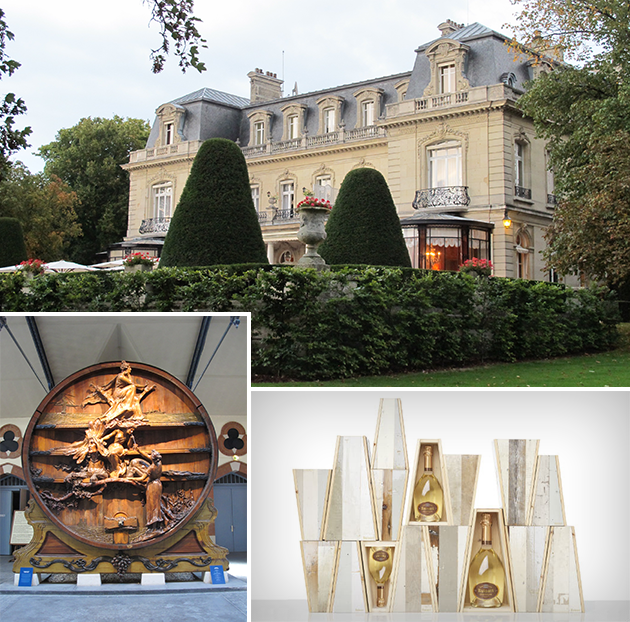
Paris has everything you could want — even a beach in the summer. But what it doesn’t have is champagne cellars, let alone underground Gallo-Roman champagne cellars several miles long. A 45-minute train ride from Paris sits the beautiful region of Champagne-Ardennes, where the world’s top champagne houses are open for visits throughout most of the year. Next time you visit the City of Lights, make time for a quick trip to this storied appellation.
Reims, the capital of region, is the main draw, and aside from its 13th-century Gothic Notre-Dame de Reims cathedral, the Saint-Nicaise hill dotted with champagne houses, is the highlight. Five of the houses have the benefit of being built within crayères (limestone mines) dug by the Gallo-Romans, who extracted the stone for building the walls that originally wrapped around the city center. The Benedictine monks who lived in the Saint-Nicaise Abbey that once stood in place of Maison Taittinger were among the first to produce sparkling wines, and it is widely thought that high-priest Dom Pérignon (after whom the famous champagne is named) was the first to establish rules in champagne making.
Champagne is typically made from an assemblage of pinot noir, chardonnay and pinot meunier grapes. Today, around 15,000 families work in the Champagne AOC (Appellation Origine Controllée — a French guarantee of quality) and its 319 villages; and although countries around the world produce their own sparkling wines, only wines that originate from Champagne can officially be called “champagne.”
A five-minute walk from the top champagne houses is the exquisite Relais & Châteaux hotel, Domaine Les Crayères. Named after the limestone mines of the Saint-Nicaise neighborhood, the château has 20 beautifully appointed rooms of unrivalled comfort and character — which come complete with Hermès products in the luxurious bathrooms. The elegant château dates back to the early 20th century and is set on seven hectares (17.3 acres) of parkland, with an old world ambiance that’s irresistible, especially at La Rotonde bar. Fitted with tartan carpets and cozy velvet upholstered couches lining the curved bay windows and overlooking the gardens, it’s the perfect spot to enjoy a glass of champagne and the house foie gras. The hotel’s highlight, though, is Le Parc restaurant, headed by chef Philippe Mille. For something a little more casual (and less pricy), there is Le Jardin brasserie which is surrounded by glass walls on all sides with wonderful views of the lush gardens.
When in Reims, save time to explore several champagne houses. At Maison Taittinger, our guide explained that the monks would make their own wine and found that the temperature in the crayères was at a constant 50 F — just the right temperature for storing wine. At Taittinger, our host was extremely informative and brought the entire champagne elaborating process to life. Being the last family-run maison de champagne gives Taittinger its distinct ambiance. Since its creation in 1734, before Monsieur Pierre Taittinger bought Château de la Marquetterie from the Forest-Fourneaux family in 1932, the house’s champagnes have evolved to include nine different types.
Maison Ruinart is another must-hit. In 1729, Nicolas Ruinart fulfilled his uncle Dom Thierry Ruinart’s ambitions and created the very first champagne house, the prestigious Maison Ruinart. Ever since its creation, the maison has always had strong links to the art world; the latest artist to be commissioned for a traveling installation is Dutch artist, Piet Hein Eek who makes beautifully designed wooden boxes for the Ruinart blanc de blancs.
Today, the Maison Ruinart is one of the most distinguished champagne brands in the world, and the house itself (although built in the 18th century) is as beautiful as ever — especially after its refurbishment, which added a sleek contemporary edge to the centuries-old property. The maison entered the LVMH conglomerate (Louis Vuitton Moët Hennessy) in the 1960s, but has retained its savoir faire and continues to do what it does best: produce its small, select number of five champagnes.
Another great stop in Reims is Maison Vranken Pommery. Founded by Narcisse Greno in 1836 (who was joined by Louis-Alexandre Pommery in 1856), the business really came into its own in 1858 when Greno passed away and Jeanne-Alexandrine Louise Pommery took over — having a woman at the top of such an empire made the house extremely avant-garde for its time and Pommery is still an innovator today. Madame Pommery played a key role in the development of champagne by introducing brut champagne in 1874 (champagne was sweet beforehand and enjoyed primarily as an aperitif). The brut meant that champagne could be paired with food, and if more champagne was had, it meant more champagne could be sold, creating a thriving industry.
Our visit to Maison Ruinart was intimate and unrushed, reflecting the brand’s philosophy. With groups of up to 30 people, visits to the Maison Vranken Pommery crayères were decidedly more chaotic. However, the Pommery cellars are impressive, primarily thanks to the monumental underground art installations throughout the 11-plus miles of passageways. Madame Pommery, a keen art enthusiast opened the cellars in 1868 with Gustave Navet’s bas-reliefs, which can still be admired today. It’s possible to see works such as Daniel Firman’s Würsa, a giant elephant hanging upside down in the lobby of the enormous château-like blue building, and French artist, Daniel Buren’s iconic black and white stripes leading to the first gallery.
Photos Courtesy of Rooksana Hossenally and Ruinart

